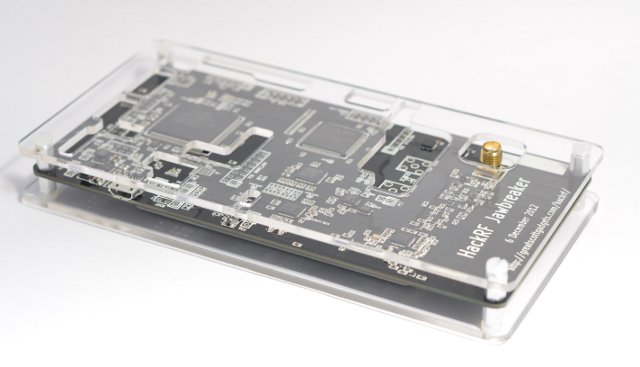HackRF is an open source hardware project to build a Software Defined Radio (SDR) supporting a frequency range between 30 MHz and 6GHz in both directions (Tx and Rx, half-duplex) with a maximum bandwidth of 20MHz. Jawbreaker (shown below) is a beta hardware that has been tested by several developers and beta testers, and applications such as Digital Audio Broadcasting (DAB), Bluetooth monitoring, spectrum sensing, wireless microphones, AIS, FM radio, etc.. have already been ported to the platform. In order to lower the cost of the hardware, Michael Ossmann has launched a Kickstarter campaign to fund mass production. There seems to be many SDR enthusiasts as the campaign has already reached its funding target ($80,000) and received for over $300,000 in ledges.

What is Software Defined Radio (SDR) and What Can it Be Used for?
Before providing details about the hardware and software, it may be useful to provide some general information about SRD and its applications. Here’s how they’ve defined it in the Kickstarter campaign page:
SDR is the application of Digital Signal Processing to radio waveforms. It is similar to the software-based digital audio techniques that became popular a couple of decades ago. Just as a sound card in a computer digitizes audio waveforms, a software radio peripheral digitizes radio waveforms. It’s like a very fast sound card with the speaker and microphone replaced by an antenna. A single software radio platform can be used to implement virtually any wireless technology (Bluetooth, ZigBee, cellular technologies, FM radio, etc.).
Digital audio capabilities in general purpose computers enabled a revolution in the sound and music industries with advances such as hard disk recording and MP3 file sharing. Today’s computers are fast enough to process radio waveforms in similar ways, and the radio communications industry is going through the same sorts of changes. One critical advance is finally taking place now, and that is the availability of low cost tools enabling anyone to take part in the revolution.
So that means you have one hardware platform that you could use for virtually any wireless protocol. Create your own FM radio, mini GSM base station, experiment with Bluetooth, Wi-Fi, Zigbee, etc…
If you look at the United States Frequency Allocations as of 2011 (PDF), you’ll find out the allocated spectrum ranges from 9Khz to 275GHz, so even though HackRF has a range limited to 30 MHz to 6GHz (300 kHz to 30 MHz is also available with the Ham It Up), you’ll find HackRF can still be used for a very large number of applications, including government reserved ranges. I hope the project won’t get into troubles with the latter, especially when it comes to exports.
HackRF Hardware
HackRF Hardware Specifications:
- MCU – NXP LCP4330 dual core ARM Cortex M4/M0 (LPC4330FBD144)
- CPLD – Xilinx XC264A CoolRunner-II (XC2C64A-7VQG100C)
- RF ICs –
- Frequency Range:
- 30 MHz to 6 GHz
- 300 KHz to 30 MHz accessible when paired wit Ham It Up RF upconverter
- Bandwidth – 20 MHz max
- Transmit Power (Preliminary, based on Jawbreaker beta hardware):
- 30 MHz to 100 MHz: 5 dBm to 15 dBm, increasing as frequency decreases
- 100 MHz to 2300 MHz: 0 dBm to 10 dBm, increasing as frequency decreases
- 2300 MHz to 2700 MHz: 10 dBm to 15 dBm
- 2700 MHz to 4000 MHz: -5 dBm to 5 dBm, increasing as frequency decreases
- 4000 MHz to 6000 MHz: -15 dBm to 0 dBm, increasing as frequency decreases
- Transceiver – Half-duplex
- Optional Add-ons – PortaPack: LCD screen, directional buttons, and audio ports for standalone use.
- Power – USB (5V)
You can get the schematics for Jawbreaker Beta board in KiCad format, as well as download the assembly files, schematics (PDF), BoM, and gerber files. I’d assume the final hardware may be slightly different (TBC).
HackRF Software
HackRF beta units can be used on Linux, MaC OS X, and Windows platforms, and connected via the USB port of your PC. HackRF already works with the GNU Radio software framework, but support can be added to other SDR software as well.
You can retrieve the firmware for the CPLD and MCU on github, and they’ve also released host files for HackRF tools and library. As mentioned in the introduction, the beta hardware has already been used with Digital Audio Broadcasting (DAB), Bluetooth monitoring, spectrum sensing, wireless microphones, AIS, FM radio, and more. More information explaining how to work with the platform is available on the Wiki.
Many people will probably just use the device connected an Host computer via USB, but it’s also possible to use it in standalone with PortaPack add-on to expand the hardware with a display, keys, and audio ports.
Kickstarter Pledges
Before I mention the pledge you may want to watch the Kickstarter promo video.
In you are interested in this project, you can pledge $275 to receive HackRF board with enclosure and telescopic antenna. Shipping is $15 for people living outside the US, and delivery is expected in January 2014. However, if you need to access the 300KHz to 30MHz range, for example for AM Radio, you’ll need to pledge $310 to add Ham It Up RF upconverter for MF and HF bands. Shipping and estimated delivery at the same. Other pledges are also available if you need more than one.
Further information is available on Kickstarter, as well as on Great Scott Gadgets’ HackRF page.

Jean-Luc started CNX Software in 2010 as a part-time endeavor, before quitting his job as a software engineering manager, and starting to write daily news, and reviews full time later in 2011.
Support CNX Software! Donate via cryptocurrencies, become a Patron on Patreon, or purchase goods on Amazon or Aliexpress




